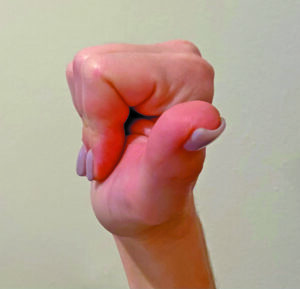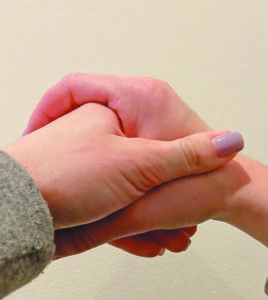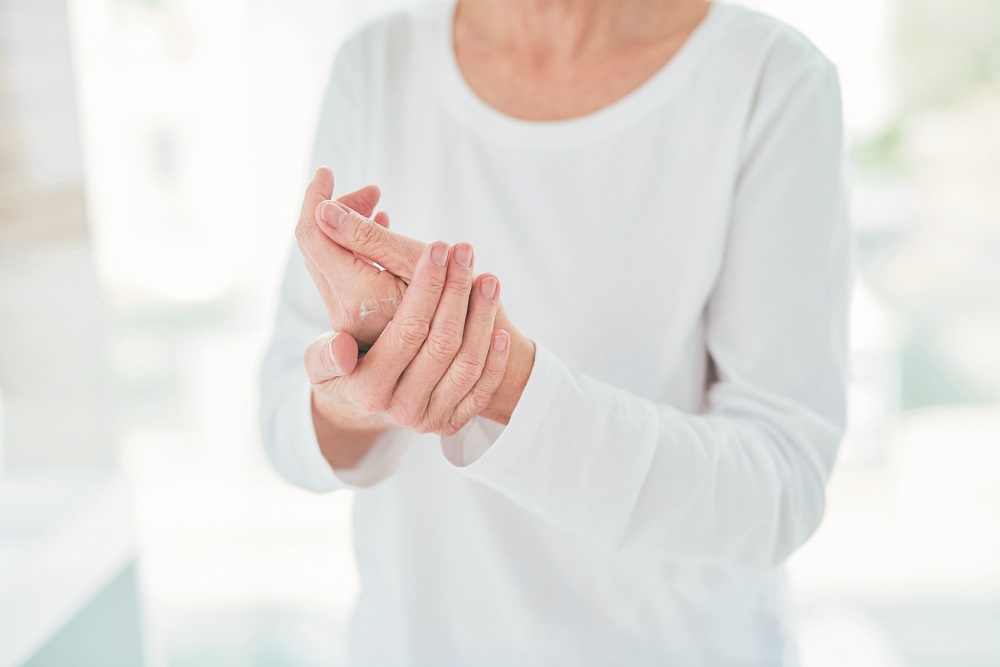Many of us have trouble opening stubborn jars—that can happen at any age. But as you get older, specific issues with your hands—weakness, pain, joint stiffness, swelling, decreased dexterity—may affect your ability to perform normal daily activities. These symptoms often stem from degenerative changes caused by osteoarthritis, osteoporosis, rheumatoid arthritis and other conditions—they are called intrinsic factors.
Extrinsic factors also can play a part. External influences that add to inflammation and wearing down of cartilage include placing unnecessary stress on the small joints of the hands through overuse or repetitive motions. For instance, rather than stopping an activity when our hands are getting tired, we switch hand positions to keep going. Even diet can have a negative impact—too much salt and fatty foods, not getting enough fluids, and not eating enough fruits and vegetables. All too often, we take our hands for granted. Here’s how to show them the TLC they deserve.
Give Your Hands a Break
Use these strategies to make everyday activities easier on your hands…
Use your larger and stronger joints rather than your hands and wrists to do heavy lifting. Examples: Use your arm to push open doors rather than your fingers. When carrying a bag with a strap, sling it over your shoulder or place it in the crook of your elbow. If you must use your hands, use your palms, not your fingertips.
Conserve energy. Take intermittent breaks during activities that last longer than 30 minutes, such as gaming or knitting.
Try adaptive tools to reduce the workload on your hands. Examples: To open jars and containers, use a nonslip rubber jar opener or an opener with long levers. Or consider a multi-function kitchen tool—a six-in-one or five-in-one container opener that works for jars, bottles, wine bottles, cans and more. No single adaptive device is right for everyone, so it may take some trial and error to find what’s best for you.
Avoid using your fingers when you don’t have to. Hold your phone with a grip band or a knob. Examples: The PopSocket, available on Amazon for about $10, adheres to the back of your phone, allowing you to hold it between your index and middle fingers. Rest a book (or Kindle) on your lap or a table rather than holding it in your hands.
Increase the diameter of objects you must hold to reduce the stress on your hands. Examples: Use a pen grip or an ergonomic pen, such as the PenAgain (available on Amazon.com), when writing. Add a grip enhancer to your toothbrush and kitchen utensils—you can find foam tubing made for this exact purpose online.
Soothing Treatments
Fingerless compression gloves, available online or at drugstores, provide light thermal heat and compression to reduce swelling and pain. Caution: The gloves should feel like a light hug on your hands. Seams should be on the outside to prevent impressions in your skin.
Ice or heat modalities, including ice packs and heating pads. Heat helps with blood circulation, joint mobility, and pain. A heating pad placed over your hands often does the trick. Caution: If your fingertips have decreased sensation, be careful with any hot or cold approach.
When to see a hand therapist: Consider seeing a therapist as soon as you notice changes, such as weakness, pain or numbness in your hands. To find a certified hand therapist (CHT): Go to HTCC.org. A CHT can be a physical or occupational therapist who specializes in treating the hand. He/she will provide information based on each person’s individualized needs, analyze how you perform various activities and offer modifications that will get you back to doing the things you love. He also can tailor an individualized home exercise program based on your needs and provide splinting options, if necessary. At most comprehensive clinics, you can test-drive assistive devices, so you’ll know exactly which ones work for you. One session with a hand therapist is enough for many people.
Exercises for Better Hand Mobility
The following exercises are safe for everyone, whether you have mobility issues or simply want to help prevent these issues from developing.
Gentle movements can help with range of motion and weakness in your hands. Here’s a simple program you can follow daily, up to three times throughout the day. Repeat each exercise three to five times with each hand. Important: Exercises should never cause pain. If these do, stop and contact a hand expert.
Tendon Gliding Exercises: Start with fingers straight, palm open. Begin slowly transitioning to a table top position by bending the fingers at the knuckles while keeping the other two joints straight. Move to a half fist by bending the middle joints and keeping the top joints straight. Next move into a full fist by curling the top joint into the palm. End by rolling up into a hook fist—keep the top and middle joints bent while extending the knuckles.



Thumb Opposition with Finger Slide. Touch the tip of the thumb to the tip of each finger, starting with the index and working one finger at a time to the pinky. When performing this exercise, try to focus on making an “O” with the thumb and each finger. Next work on sliding your thumb down the length of each finger to where it meets the palm.

Webspace Massage. Massage the webbed area between your thumb and index finger with lotion to loosen up the muscles. Caution: Don’t be too aggressive.

Thumb C Isometric. Wrap your hand around a small stress ball, making a C shape with your index finger and thumb. Be sure the ball is placed in the palm of your hand—don’t force it into the webspace. Gently squeeze the ball to create a muscle contraction. The goal is to not squeeze hard, but rather to produce enough force for a muscle contraction only. Stress balls are available on Amazon.com for about $10.

Index Abduction. Place your hand flat on a table. Move your index finger out to the side and then back next to the middle finger.

Wrist Isometrics. Protect your fingers by also protecting your wrists. For each of these exercises, use only moderate resistance to counter the pressure from your other hand.
Wrist extension. Place your wrist in a slight extension (pressed back toward the forearm), and use your other hand to apply a downward pressure.

Wrist Flexion. Place your wrist in slight flexion (lowered away from the forearm), and use your other hand to apply a downward pressure.

Ulnar Deviation. Make a fist with your right hand, and use your left hand to apply an upward pressure on the pinkie side of your wrist. Press down with your wrist to resist the pressure.

Radial Deviation. Make a fist with your right hand, and use your left hand to apply downward pressure on the thumb side of your wrist. Press up with your wrist to resist the pressure.

Could Your Hand Stiffness be Dupuytren’s?
Dupuytren’s contracture is believed to be a hereditary condition that primarily affects the hands, although it also can affect the feet (known as Ledderhose disease). The first signs are small palpable nodules and cords in the palm of the hand. For some people, this may be the only symptom that occurs throughout their lifetime. But for others, it can progress into fixed bent positions of the fingers, otherwise known as flexion contractures. It can affect one or multiple fingers in one or both hands, and the progression can be aggressive or slow in nature.
Best: Avoid aggressively stretching or massaging the hand. Once the contracture begins interfering with your daily activities, see a hand surgeon. There’s no cure for Dupuytren’s contracture, but there are treatments that can break up the cords that are restricting movement.


